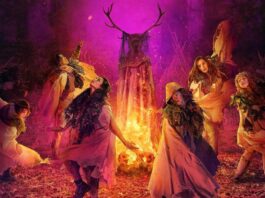Looming over the second half of the twentieth century was the dire threat of nuclear war. Tensions between America and the Soviet Union and The People’s Republic of China dominated the public consciousness. The fear permeated everything. And as everyone knows, culture affects the pieces of media produced in that period. This is especially true of The Belgariad and The Mallorean, written by David and Leigh Eddings. While David is the only author credited as writing, in the Rivan Codex he acknowledges that his wife co-wrote all his books.
The two of them wrote ten books in The Belgariad and The Mallorean, from 1982 to 1991, ending when the Soviet Union collapsed. Both were adults through the course of the Cold War. You can see the Cold War and how it resonates through them heavily in the books. Despite being a medieval fantasy series that relies heavily on character archetypes, it has been influenced by the cultural zeitgeist. This makes it the converse of other stories that create the culture of the time.
Ultimately, the two series serve as a metaphor for the Cold War. This series of articles will unpack how each novel serves as a metaphor, follow several recurring issues related, and look at what the series serving as a metaphor means for the books as a whole.
Introduction
Pawn of Prophecy tells the story of Garion. He starts out as a young boy being raised by his Aunt Pol on a farm. Over the course of the book we see Garion and his Aunt leave the farm. They do so at the behest of Mister Wolf, a travelling story teller, later revealed to be the Sorcerer Belgarath. Garion discovers Aunt Pol is Belgarath’s daughter, the Sorceress Polgara, and evidently much more distantly related. They journey, with several other companions, along the trail of a mysterious item that was stolen from the kingdom of Riva.
Asharak the Murgo follows and hounds their company. (Murgos are one subdividision of Angaraks, who are coded as the villains.) They are then escorted to the King of Sendaria. That king forces them to go to Aloria so that Belgarath can confer with the kings of the Alorns to discuss the theft. (The Alorns are four peoples, the Rivans, Drasnians, Algerians, and Chereks.) At said conference Garion accidentally discovers a conspiracy by the Earl of Jarvik to unseat the King of the Chereks and to deliver Garion to Asharak. The foiling of said plot marks the climax of the first book.
Overall, it’s a decent start to the series. Though the reader, like Garion, is left wondering at several things at the end. There are implications that Garion has an important heritage beyond Belgarath and Polgara, though that is explored more in the sequels.
Torak and the Iron Curtain
From the very beginning, we see the Cold War metaphor displayed through the imagery heavily associated with the villain. The Dark God, Torak, is the villain of the piece from the prologue. We see Torak instigate war between himself and his fellow gods, all for the sake of possessing the Orb of Aldur.
The Orb will be discussed in greater detail in a later piece, but what is of interest now is that, “Torak raised the Orb and…split the earth asunder.” (Pawn of Prophecy, 2). Torak completely alters the geography of the planet. He creates a physical barrier that deeply divides people. Torak shatters the earth, which creates a sea that divides the Angaraks, his followers, from all others. He also creates mountain range, which is the only way to cross from the West into the East.
To any student of the Cold War, this will sound intimately familiar to the Berlin Wall. Torak’s actions make him similar to the Soviets that built the wall in the first place. This metaphor carries on Torak’s description. While Churchill’s famous ‘Iron Curtain’ speech is metaphorical, it is less so here.
After Torak uses the Orb to divide the Angaraks from the Alorns and other peoples of the West, he has to face the consequences of his actions. The Orb punishes him by burning the half of his body with unending fire. To hide his maiming, Torak wears a steel mask. This is described in a pageant held in honor of the seven gods. “And finally the last figure, which, … was robed in black and whose mask was made of steel instead of painted wood. ‘I am Torak,’ ” (Pawn of Prophecy, 54). Steel is a refined form of iron, and Torak wears a literal steel mask to hide his face. It’s one of the more obvious parallels in the series.
Red Gold and the Red Flags
One of the subtler examples of this in the series is the currency that the Angaraks use. As this is a medieval fantasy universe, we are right to expect that gold is the major currency. However, the interesting thing comes in the description of said currency. When we first encounter it, we are just told each coin is stamped with Torak’s face.
The book continues, and we see this mysterious money appear more frequently. The second time we encounter it is just before Polgara, Belgarath, and Garion leave the farm. Garion discovers that Brill, a new farmhand, has been following Polgara. When Belgarath catches Brill acting shiftily, he sees Murgo gold in his coin-purse. When Polgara objects to leaving the farm, Belgarath tells her, “Brill had a pouchful of good red Angarak gold. The Murgos have set eyes to watching this place.” (Pawn of Prophecy, 67). Angarak gold is red.
What in the Cold War era is also red? Just about every single thing aligned with communism, that’s what. Given what that doctrine has to say about capitalism, which is in many ways aligned with gold, this feels significant. The currency of the people coded villains is red, and as we later find out, seductive.
The last time we see Angarak gold in this book is during the confession of the Earl of Jarvik. Belgarath says, ” ‘It’s the nature of Angarak gold,’… ‘It calls to its own. The more one has, the more it comes to possess him. That’s why Murgos are so lavish with it. Asharak wasn’t buying your services, Jarvik; he was buying your soul.” (Pawn of Prophecy, 228).
The addictive nature of Angarak gold combined with the Cold War’s dueling philosophies makes for a conundrum. You have the gold that sounds capitalist’s clarion call, branded with communism’s colors. That signals an attempt to use Western ideology to bind a person to Eastern interests. The ways in which Angaraks use their gold, to buy spies and political insurgents, supports this belief.
McCarthyism and Cherek
The climax of the story is the discovery of a conspiracy to unseat King Anheg and deliver Garion to Asharak the Murgo. Garion had spied on the Earl of Jarvik and a green-cloaked man meeting with Asharak. When he gave his testimony to the Alorn Kings, Anheg sent out men to capture Jarvik and his cohorts. Garion’s accusations lead to the arrest and the death of Jarvik and his cohort. Asharak escaped the men sent out after him after a final attempt to capture Garion, though Anheg put a bounty on his head.
This may seem to have very little to do with the Cold War, but it serves as the clearest metaphor in the series for one of the most contested events on American soil.
The McCarthy era, or the Second Red Scare, was a period where American fear of Soviet spies lead to rampant persecution. Anyone with any association with communist ideology was suspect, and many lost jobs because of it. Anheg says to Jarvik that “No Angarak has set foot on Cherek soil since the days of Bear-shoulders himself.” (Pawn of Prophecy, 229). This line brings to mind the oppressive nature of the McCarthy Era.
This correlation is heightened by the quote from early in the story by Belgarath of, “If you simply assumed all Murgos are spies you wouldn’t be too far from the truth.” (Pawn of Prophecy, 79). Each Murgo, or leftist in the 1950s, was seen as just being a mouthpiece for Soviet propaganda and seen as a danger to the state. While we know that this is not the case for the vast majority of those persecuted by McCarthy, in the novel is is widely thought true. Asharak and Brill are both tangible threats to our heroes.
David and Leigh Eddings had several decades between the end of the Second Red Scare and when Pawn of Prophecy was published. However, they created a fantasy world where all of the greatest fears of that era were true.
Conclusion, For Now
Over the course of their first novel, David and Leigh Eddings create a world. It draws heavily on the conventions of medieval fantasy, in ways that make it seemingly predictable. However, the quirks that they give their characters, and the subtext of their universe make it immensely memorable. There are several characters and thematic parallels that were established in this book will be continued through the series. The Angarak Coin and Iron Curtain metaphors become even more significant over time to list a few elements. In the next books there are moments that echo other events in the Cold War, and more metaphors and corollaries appear.




